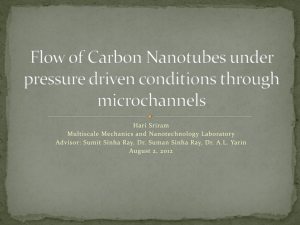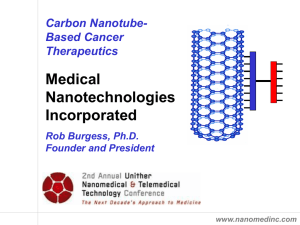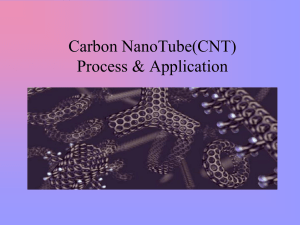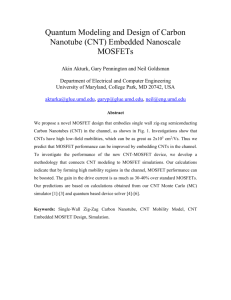Introduction
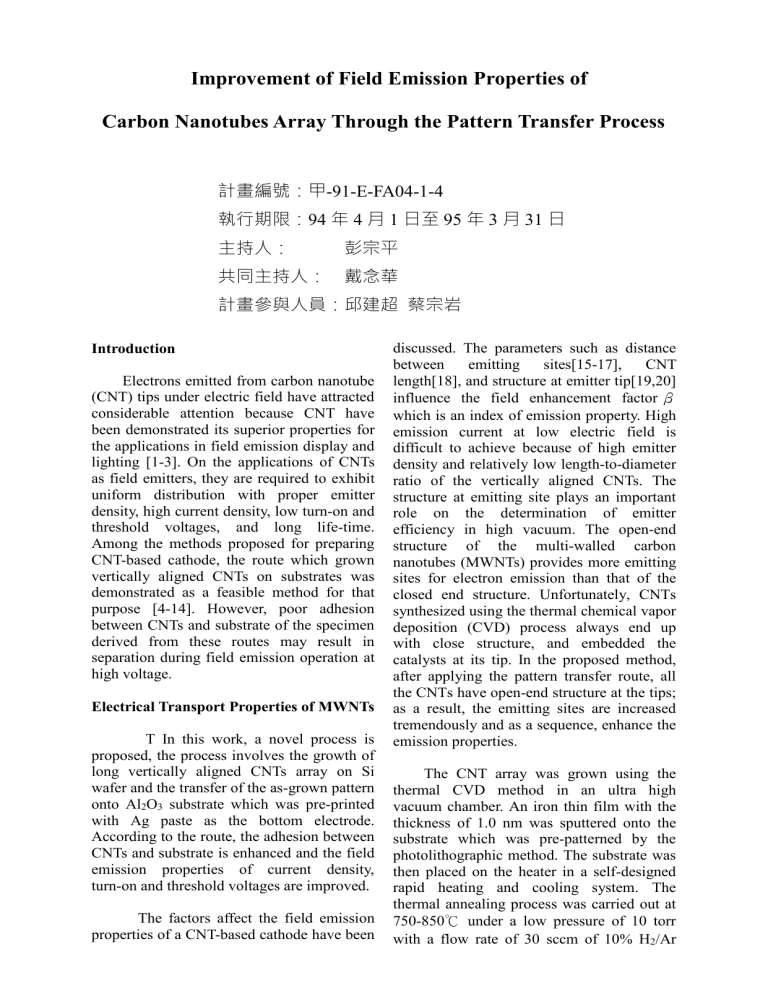
Improvement of Field Emission Properties of
Carbon Nanotubes Array Through the Pattern Transfer Process
計畫編號:甲
-91-E-FA04-1-4
執行期限:
94
年
4
月
1
日至
95
年
3
月
31
日
主持人: 彭宗平
共同主持人: 戴念華
計畫參與人員:邱建超 蔡宗岩
Introduction
Electrons emitted from carbon nanotube
(CNT) tips under electric field have attracted considerable attention because CNT have been demonstrated its superior properties for the applications in field emission display and lighting [1-3]. On the applications of CNTs as field emitters, they are required to exhibit uniform distribution with proper emitter density, high current density, low turn-on and threshold voltages, and long life-time.
Among the methods proposed for preparing
CNT-based cathode, the route which grown vertically aligned CNTs on substrates was demonstrated as a feasible method for that purpose [4-14]. However, poor adhesion between CNTs and substrate of the specimen derived from these routes may result in separation during field emission operation at high voltage.
Electrical Transport Properties of MWNTs
T In this work, a novel process is proposed, the process involves the growth of long vertically aligned CNTs array on Si wafer and the transfer of the as-grown pattern onto Al
2
O
3
substrate which was pre-printed with Ag paste as the bottom electrode.
According to the route, the adhesion between
CNTs and substrate is enhanced and the field emission properties of current density, turn-on and threshold voltages are improved.
The factors affect the field emission properties of a CNT-based cathode have been discussed. The parameters such as distance between emitting sites[15-17], CNT length[18], and structure at emitter tip[19,20] influence the field enhancement factor β which is an index of emission property. High emission current at low electric field is difficult to achieve because of high emitter density and relatively low length-to-diameter ratio of the vertically aligned CNTs. The structure at emitting site plays an important role on the determination of emitter efficiency in high vacuum. The open-end structure of the multi-walled carbon nanotubes (MWNTs) provides more emitting sites for electron emission than that of the closed end structure. Unfortunately, CNTs synthesized using the thermal chemical vapor deposition (CVD) process always end up with close structure, and embedded the catalysts at its tip. In the proposed method, after applying the pattern transfer route, all the CNTs have open-end structure at the tips; as a result, the emitting sites are increased tremendously and as a sequence, enhance the emission properties.
The CNT array was grown using the thermal CVD method in an ultra high vacuum chamber. An iron thin film with the thickness of 1.0 nm was sputtered onto the substrate which was pre-patterned by the photolithographic method. The substrate was then placed on the heater in a self-designed rapid heating and cooling system. The thermal annealing process was carried out at
750-850 ℃ under a low pressure of 10 torr with a flow rate of 30 sccm of 10% H
2
/Ar
mixture for 5-10 minutes. Acetylene, which acts as the carbon source, was then introduced into the chamber at a flow rate of
60 sccm. The thickness of CNT array was controlled in the range of 50 and 200
m by adjusting synthesis temperature and period.
The process of transferring CNT array from Si wafer to alumina substrate which was screen-printed with Ag paste for several
m was schematically shown in Figs.
1(a)-(c). After the transfer process, the as-grown CNT array was stuck in the uncured Ag paste, the specimen was then heated at 150 ℃ for 30 min in air to evaporate the solvent, and annealed at 530 ℃ under 10% H
2
/Ar mixture for 30 min to cure the paste. After curing process Si wafer was removed and the CNTs were adhered firmly onto the Al
2
O
3
substrate. The morphologies and the microstructure of the synthesized
CNTs array were examined by the field emission scanning electron microscope
(FESEM, JEOL 6500F) and the high-resolution transmission electron microscope (HRTEM, JEOL 2010), respectively. The field emission measurement was carried out using Keithley 237 in a vacuum of 10
-6
torr.
The SEM images depicted in Figs.
1(d)-(f) showed the CNT morphologies before, during, and after transfer process, respectively. The CNTs were grown with a pattern of block array with an area of 100
m
× 100 m in each block. Different CNT lengths were synthesized by controlling the synthesis period. Fig. 1(d) shows the SEM image of the as-synthesis CNTs array. During the transfer process, the Ag paste was expelled by CNT blocks and was stuck around the blocks, as shown in Fig. 1(e).
After the transfer process, the roots of as-synthesis CNTs become upward. Although the CNTs became buckle due to applied load during transfer process; however, the pattern was maintained, as shown in Fig. 1(f).
The relationship between field emission current density and applied electric voltage for different patterned arrays with block size from 100 to 400
m was shown in Fig.
2(a). The CNT length and the gap between blocks were kept at 50
m and 100
m, respectively, for all the cases. The specimens, with the ratios of covering area of CNTs on substrate of 0.33, 0.56, 0.73, and 0.79 corresponding to the block sizes of
100, 200, 300, and 400
m, respectively, were prepared. In this study, the ratios reflected the numbers of CNTs on tested specimen. Besides CNT number, electric field distribution within the specimen is also important. Since the local electric field at the emission site affects the emission property, the size of CNT block play an important role for optimizing the field emission property. Due to the screening effect, the current density increases with the decrease of block size, as shown in Fig. 2(b).
The inset in Fig. 2(a) shows the F-N plot of the measurements and it indicates that the turn-on field decreases by decreasing the block size. If the transfer process was not applied, the as-synthesis CNT array was detached easily from Si wafer when the specimen was subjected for field emission measurement under a voltage higher than
600 V. However, no separation between
CNT array and alumina substrate was detected even a high voltage of 1100 V was applied during field emission test. It shows that the adhesion between CNTs and alumina substrate was improved after the transfer process.
Figure 3 shows the relationship between field emission current density and applied electric voltage for the CNTs array with the same block size of 200
m and different
CNT lengths from 50 to 200
m. It is observed that the current density increases with the CNT length. The F-N plot in the inset reveals that the turn-on field decreased by increasing the length of CNTs arrays.
Extremely high current density of 325 mA/cm
2
and low turn-on field of 0.55 V/
m were achieved when the CNT with 200
m in length was tested. The tested field emission data for different lengths of CNTs array are shown in Table 1. The field enhancement factor β was obtained using the relation,
J
A
2
F
2 exp
6 .
83
10
9
F
2
3
,
(1) where J is emission current density , A is a constant, Φ is work function ( eV ), and F is macroscopic applied electric field. Based on the data shown in Table 1, it is detected that β increases several times as the length increases from 50
m to 200
m, it also implies that the local field is affected by the CNT length, as a result, enhance the current density.
The structure of emitting site affects the field emission property. The HRTEM images as shown in Figs. 4(a) and 4(b) depicted the tip and the root, respectively, of the as-synthesis CNTs. Fig. 4(a) shows the closed structure at the tip of the as-synthesis
CNT, which the catalytic particle was embedded by graphitic layers. The CNT root, as shown in Fig. 4(b) shows open-structure without catalytic particle attached. The rough open-structure at the
CNT tip provides more emitting sites after the transfer process, as a result, enhances the current density.
In summary, a novel and effective method by transfer the CNTs array from Si wafer onto the Al
2
O
3
substrate to enhance the emission properties of the aligned CNT array has been demonstrated. Current density and turn-on voltage were improved by decreasing the block size and increasing the CNT length.
Low turn-on field of 0.55 V/
m and extremely high current density of 325 mA/cm
2
at 2.4 V/
m were achieved for the
CNT array with 200
m in block size and
200
m in length. The high current density is attributed to the increase of emitting site at
CNT tips because of the inherent open structure after the transfer process. Moreover, the adhesive between CNT array and substrate was also improved.
Acknowledgement
The authors would like to thank the
Ministry of Education of the Republic of
China for financial support on this research under Contract
甲
-91-E-FA04-1-4
Table 1. The data of field emission measured from different lengths of CNTs array.
Thickness
(
m)
J at 960 V
(mA/cm 2 )
E
0
β
50 19
(v/
m)
0.95 2960
60
240
325
0.80
0.65
0.55
4149
17140
20513
80
116
200
(a)
(b)
(c)
200
m
200
m
100
m
Figure 1. SEM images of CNTs array transfer process. (a) The as-grown patterned CNT array. (b) Put on the Al
2
O
3
substrate which was pre-printed with several
m Ag paste for
1-10 min. (c) Remove the Si wafer.
35
30
25
20
15
10
5
0
0
2
0
-2
-4
-6
-8
-10
-12
0
200
2
size E
0
(V/
μm)
100 0.65
200 0.95
300 1.20
400 1.35
4 6
1/E( m/V)
8 10 12
400 600 800
Voltage (V)
1000
(a)
35
30
25
20
15
10
5
1.4
1.2
1.0
0.8
0
100 200 300
Size ( m)
400
0.6
(b)
Figure 2. (a) The relationship between field emission current density and applied electron voltage for the different patterned sizes of the tip from 100 to 400
m of CNT array. The inset is the F-N plot. (b) The tendency of the current density and turn-on field relating to the block size of the CNTs array.
350
300
250
4
2
0
-2 thickness E
0
(V/
μm)
200 0.55
116 0.65
80 0.80
50 0.95
200 -4
-6
150
100
50
-8
-10
-12
0 2 4 6 8
1/E( m/V)
10 12
0
0 200 400 600
Voltage (V)
800 1000
Figure 3. The relationship between the current density of field emission and applied electric voltage for the CNTs array with the same block size of 200
m and different
CNT lengths from 50 to 200
m. The inset is the F-N plot
(a)
(b)
Figure 4. The HRTEM images of CNTs before the transfer process. (a) The tip of the
CNT shows the shows the close-end structure with the catalytic particle embedded by graphitic layers. (b) The root depicts the open-end structure without catalytic particle embedded.
References
[1].J.-M. Bonard, T. Stockli, O. Noury, A.
Chatelain, Appl. Phys. Lett. 2001 , 78 2775.
[2] A. Fujiwara, Y. Takahashi, Nature 2001 ,
410, 560.
[3] A. Javey, M. Shim, H. Dai, Appl. Phys.
Lett. 2002, 80, 1064.
[4] Z. F. Ren, Z. P. Huang, J. W. Xu, J. H.
Wang, P. Bush, M. P. Siegal, Science 1998 ,
282, 1105.
[5] Z. W. Pan, S. S. Xie, B. H. Chang, C. Y.
Wang, L. Lu, W. Liu, Nature 1998 , 394 631.
[6] Y. Y. Wei, G. Eres, V. I. Merkulov, D. H.
Lowndes, Appl. Phys. Lett. 2001 , 78, 1394.
[7] Y. T. Lee, J. Park, Y. S. Choi, H. Ryu, H. J.
Lee, J. Phys. Chem. B 2002 , 106, 7614.
[8] X. Zhang, A. Cao, B. Wei, Y. Li, J. Wei, C.
Xu, Chem. Phys. Lett. 2002 , 362, 285.
[9] D. B. Geohegan, A. A. puretzky, I. N.
Ivanov, S. Jesse, G. Eres, Appl. Phys. Lett.
2003 , 83, 1851.
[10] H. Cui, G. Eres, J. Y. Howe, A. Puretkzy,
M. Varela, D. B. Geohegan, Chem. Phys.
Lett.
2003, 374, 222.
[11] H. T. Ng, B. Chen, J. E. Koehne, A. M.
Cassell, J. Li, J. Han, J. Phys. Chem. B 2003 ,
107, 8484.
[12] H. M. Christen, A. A. Puretzky, H. Cui,
K. Belay, P. H. Fleming, Nano Lett. 2004, 4,
1939.
[13] G. Eres, A. A. Puretzky, D. B. Geohegan,
H. Cui, Appl. Phys. Lett. 2004 , 84, 1759.
[14] A. Cao, P. M. Ajayan, G. Ramanath, R.
Baskaran, K. Turner, Appl. Phys. Lett. 2004,
84, 109.
[15] L. Nisson, O Groening, C. Emmenegger,
O. Kuettel, E. Schaller, L. Schlapbach, Appl.
Phys. Lett.
2000, 76, 2071.
[16] W. I. Milne, K. B. K. Teo, M. Chhowalla,
G. A. J. Amaratunga, D. Pribat, P. Legagneux,
Curr. Appl. Phys. 2002 , 2, 509.
[17] V. Semet, V. T. Binh, P. Vincent, D.
Guillot, K. B. K. Teo, M. Chhowalla, Appl.
Phys. Lett. 2002 , 81, 343.
[18] M. Sveningsson, R. E. Morjan, O. A.
Nerushev, E. E. B. Campbell, D. Malsch, J. A.
Schaefer, Appl. Phys. Lett. 2004 , 85, 4487.
[19] T. Kuzumaki, Y. Takamura, H. Ichinose,
Y. Horiike, Appl. Phys. Lett. 2001 , 78, 3699.
[20] Z. W. Pan, F. C. K. Au, H. L. Lai, W. Y.
Zhou, L. F. Sun, Z. Q. Liu, J. Phys. Chem.
B 2001 , 105, 1519.
